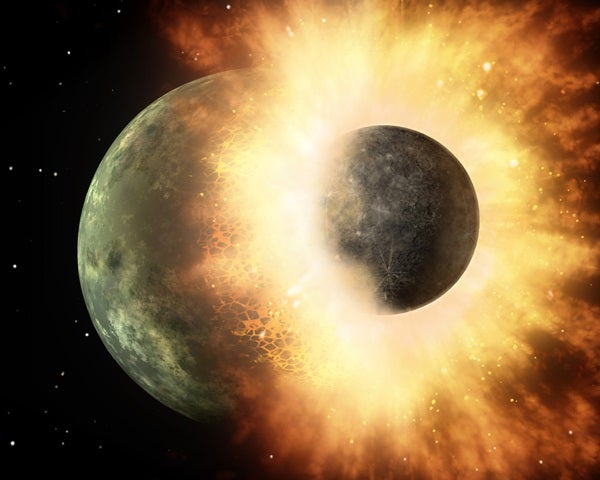Most planetary scientists believe that the Moon formed from an impact between Earth and a planet-sized body, which has been given the name Theia. Efforts to confirm that the impact had taken place had centered on measuring the ratios between the isotopes of oxygen, titanium, silicon, and others. These ratios are known to vary throughout the solar system, but their close similarity between Earth and Moon conflicted with theoretical models of the collision that indicated that the Moon would form mostly from Theia and thus would be expected to be compositionally different from Earth.
Now a group of German researchers, led by Daniel Herwartz, has used more refined techniques to compare the ratios of 17O/16O in lunar samples with those from Earth. The team initially used lunar samples that had arrived on Earth via meteorites, but as these samples had exchanged their isotopes with water from Earth, fresher samples were sought. These were provided by NASA from the Apollo 11, 12, and 16 missions; they were found to contain significantly higher levels of 17O/16O than their earthly counterparts.
“The differences are small and difficult to detect, but they are there,” said Herwartz. “This means two things: Firstly, we can now be reasonably sure that the giant collision took place. Secondly, it gives us an idea of the geochemistry of Theia. Theia seems to have been similar to what we call E-type chondrites. If this is true, we can now predict the geochemical and isotopic composition of the Moon because the present Moon is a mixture of Theia and early Earth. The next goal is to find out how much material of Theia is in the Moon.”
Most models estimate that the Moon is composed of around 70 to 90 percent material from Theia, with the remaining 10 to 30 percent coming from early Earth. However, some models argue for as little as 8 percent Theia in the Moon. Herwartz said that the new data indicate that a 50:50 mixture seems possible, but this needs to be confirmed.
The team used an advanced sample preparation technique before measuring the samples via stable isotope ratio mass spectrometry, which showed a 12 parts per million (± 3 ppm) difference in 17O/16O ratio between Earth and Moon.










